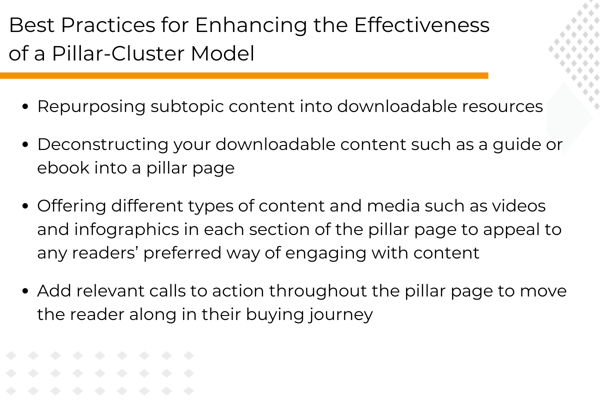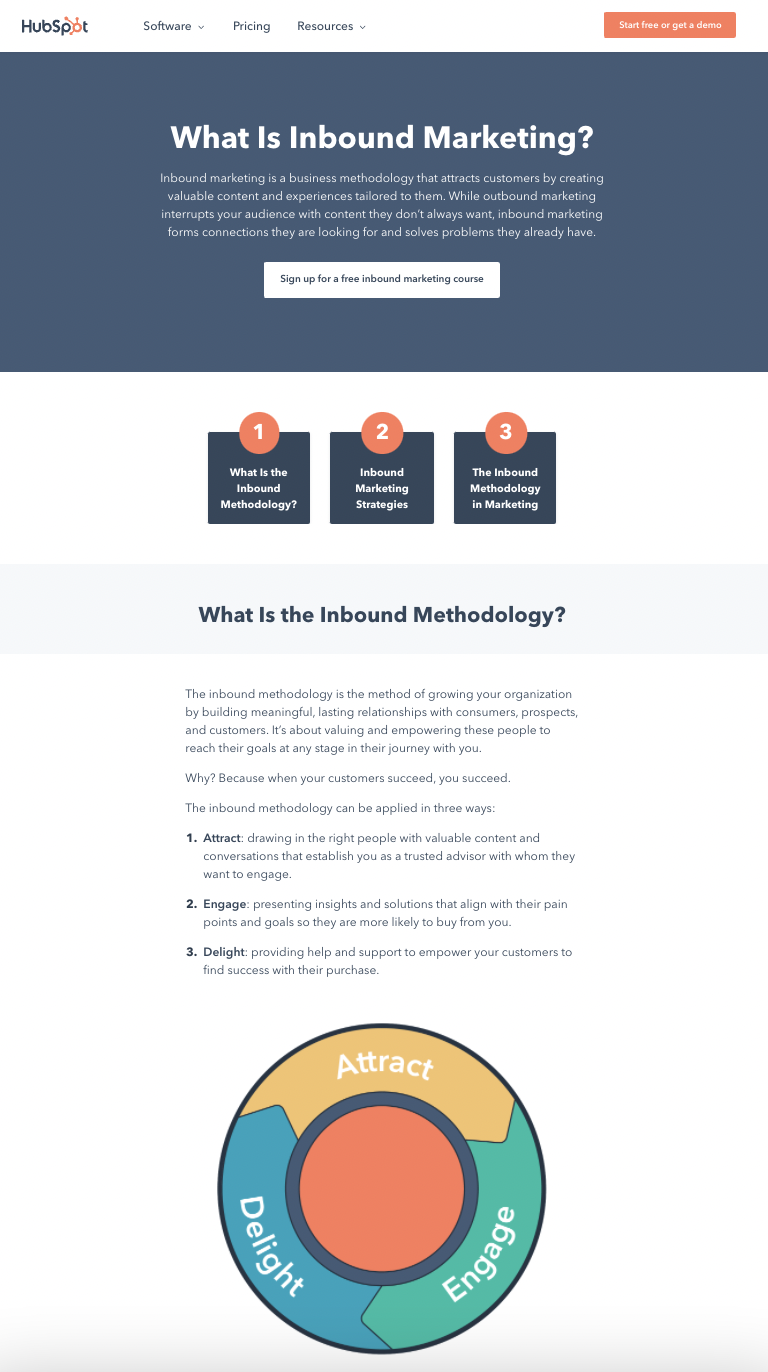How to Create an Effective Pillar-Cluster Model in 4 Steps
An effective pillar-cluster model is to SEO what meatballs are to spaghetti. Just like meatballs enhance a bowl of spaghetti, a killer pillar-cluster model amplifies your SEO strategy and results. So what is a pillar-cluster model? And how can marketers leverage this model to boost SEO and crush marketing goals? All of your most burning questions will be answered in this blog.
In this article, we’re taking you on a tour of an effective pillar-cluster model — what steps you need to take, what you should be including in the pillar page, and how to leverage it in your marketing strategy. All aboard!
Defining Pillar Pages and Supporting Content in a Pillar-Cluster Model
A pillar page is a piece of high-level content that serves up a broad overview of a particular topic. For example, a pillar page can be created for the broad topic “inbound marketing.” Typically, a pillar page is then cross-linked to in-depth blogs and other resources that discuss subtopics in-depth. Continuing with the inbound marketing topic example, these subtopics can range from holistic email marketing to SEO best practices, lead-nurturing campaigns, and more.
Together, a pillar page and all supporting content make up a pillar-cluster model. Pillar-cluster models are essential to reaching your SEO goals. In fact, studies have shown that implementing a pillar-cluster model can lead to a 40% increase in organic traffic. This model is key to effective SEO as it increases your search engine results page (SERP) ranking by:
- Showcasing your expertise on a given topic
- Increasing your page authority via link building
- Attracting new website visitors and garnering more conversions
Now that you have a better understanding of what a pillar page and supporting content are, it’s time to divulge the four steps to creating an effective pillar-cluster model.
1. Identify a Specific Topic You Want To Be Known and Rank Highly For
The first step is obvious — choose a specific topic that your business has a solution for. Think about it like this. What do you want your brand to be known for? Let’s look at a HubSpot example. HubSpot is a CRM platform that enables marketers and salespeople to “grow traffic, convert leads, close deals, and turn customers into promoters” via inbound marketing strategies. Ultimately, HubSpot is known for being a leader of inbound marketing.
Here is an example of a HubSpot pillar page that broadly describes inbound marketing: Inbound Methodology (example shown below).
On this pillar page, HubSpot makes sure to broadly explain the what, why and how of inbound marketing — what is it, why is it important, and how it can be done. Throughout the page, HubSpot cross-links to various resources where they explain a subtopic of inbound marketing such as developing a great SEO strategy in greater detail shown in the image below.
2. Identify Your Topic Cluster
The next step to creating an effective pillar-cluster model is to identify your topic cluster. This means determining which subtopics would best support your pillar page’s core topic. Best practice is to brainstorm a list of all possible subtopics that you can create content around to boost the authority of your pillar page. Let’s continue with the inbound marketing core topic example.
Below are a few subtopics that would support the inbound marketing pillar page’s authority as well as boost your brand’s credibility and expertise on inbound marketing:
- SEO strategy
- Email marketing
- The customer journey
- Creating holistic content
We could go on forever, but when it comes to pillar-cluster models, it’s best to have (at most) 20 pieces of supporting content. If you find yourself with more pieces of content that belong to a particular topic cluster, it’s likely time to separate the topic cluster into two or three smaller clusters.
For example, if your core topic is digital marketing and you have a surplus of supporting content on the subtopic of email marketing, it’s best to create a separate topic cluster for email marketing and develop supporting content on topics such as subject line best practices and deciphering email analytics.
3. Create Supporting Content for Subtopics
Now that you have your complete pillar-cluster model figured out, it’s time to develop content for each subtopic. Supporting content can come in all shapes and sizes. From blogs to case studies to landing pages and other digital resources, supporting content is key to the overall success of the pillar-cluster model. Let’s take a look at an example of supporting content for the HubSpot Inbound Methodology pillar page we showcased above.
HubSpot’s blog, The Ultimate Guide to Customer Delight is a great example of supporting content within a pillar-cluster model. This blog belongs in the Inbound Methodology topic cluster as it discusses an aspect of the methodology in greater detail — the customer delight stage of the buyer’s journey. Whereas the pillar page discussed the customer delight stage at a high-level, this blog describes:
- Who is responsible for delighting prospects and customers
- The difference between customer delight and customer satisfaction
- Strategies for how to delight customers
- Examples of customer delight
4. Link Your Relevant Content to the Pillar Page
Woo! Your content is written. Now, it’s important to hyperlink your blog back to the pillar page. This increases the domain authority of the pillar page which, in turn, increases your SERP ranking. Essentially, having internal and external links to high-quality content is sort of like sending Google and other search engines little signals that this pillar page and supporting content is credible and useful. Therefore, Google is much more likely to increase your ranking.
Let’s look at an example. HubSpot published the blog, Do You Know How to Apply the Buyer's Journey to Your Inbound Strategy? to serve as supporting content to the Inbound Methodology pillar page. How do we know this? Because this blog discusses the inbound methodology as it relates to the buyer’s journey and is hyperlinked back to the Inbound Methodology pillar page (shown in the image below).

These hyperlinks increase the credibility and quality of your blog and the associated pillar page. For more high-quality links a page has, the more authority it gains.
Extra Steps You Can Take to Enhance the Effectiveness of Your Pillar-Cluster Model
Now that you know how to create a pillar-cluster model, it’s crucial to continue building upon and developing your topic clusters to enhance the effectiveness of your content to:
- Boost SEO
- Gain greater visibility
- Garner new leads

Final Thoughts
Creating an effective pillar-cluster model won’t happen overnight or without the right team to continuously manage and monitor the progress. Plus, the success of any topic cluster depends on the value of the content and the overall SEO strategy. If you’re looking to gain new leads, increase website traffic, and boost the effectiveness of your content, reach out to us. We’re here to help.





